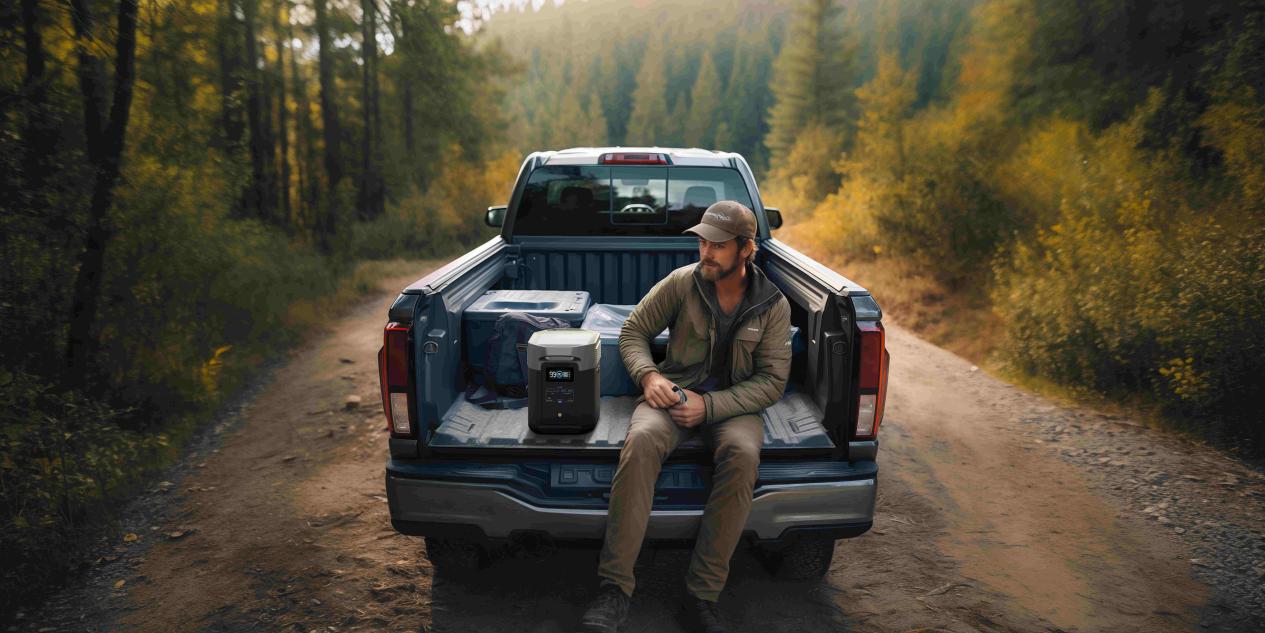- Washer Amp Use: A Quick Reality Check
- How to Calculate Amps for a Washing Machine: Step by Step
- Why the Amp Number Isn't Always the Same
- Can a Standard Home Circuit Handle a Washer?
- Ways to Cut Down Your Washer's Energy Load
- Can a Portable Power Station Run a Washing Machine?
- Powering Your Washer with EcoFlow
- Washer Amp Usage: Key Takeaways
- FAQ: Washer Amp Use, Circuits, and Backup Power
How Many Amps Does a Washer Use?
- Washer Amp Use: A Quick Reality Check
- How to Calculate Amps for a Washing Machine: Step by Step
- Why the Amp Number Isn't Always the Same
- Can a Standard Home Circuit Handle a Washer?
- Ways to Cut Down Your Washer's Energy Load
- Can a Portable Power Station Run a Washing Machine?
- Powering Your Washer with EcoFlow
- Washer Amp Usage: Key Takeaways
- FAQ: Washer Amp Use, Circuits, and Backup Power
A washing machine looks harmless—until you try to run it on backup power or plug it into a crowded circuit. Suddenly, one question matters more than anything: how many amps does it pull?
If you're setting up a laundry room, prepping for outages, or powering appliances off-grid, washer amp usage becomes the dealbreaker. It decides what works, what doesn't, and where your system might fail.
This guide sorts it out without fluff—just clear numbers, real-life cases, and the power draw truths most manuals skip.
Washer Amp Use: A Quick Reality Check
Typical washers sit between 5 to 15 amps, depending on what's under the hood and how it's being used. The power label won't always say "amps"—you'll probably see watts. But amps are easy to figure out:
| Amps = Watts ÷ Volts |
For a U.S. 120V outlet:
- A 600W washer pulls 5 amps
- A 1200W one needs 10 amps
That's the running draw—but amp spikes hit higher when the motor spins up or a heating element kicks in. It's common for the startup surge to push well beyond the stated draw. That brief moment matters most when you're using limited power sources.
How to Calculate Amps for a Washing Machine: Step by Step
Step 1: Find the washer's wattage
- Look at the label on the back of your washer or check the manual.
- You might see something like: Power: 1200W
- That means the washer uses 1200 watts.
Step 2: Know your voltage
- Most U.S. washers use 120 volts. Some larger or combo models may use 240 volts, so double-check.
- If you're using it in an RV or cabin, confirm what your power source gives.
Step 3: Use the formula Amps = Watts ÷ Volts
Example:
- If your washer is 1200W and uses 120V: 1200 ÷ 120 = 10 amps
- If it's 2000W on a 240V line: 2000 ÷ 240 = 8.3 amps
Step 4: Account for surge (startup power)
Washers use more power for 1–3 seconds when the motor starts. Multiply the amps by 2 or 3 to get the surge amps.
10 amps running × 3 = 30 amps surge
This is important if you're using a generator or power station—it needs to handle that short spike.
Step 5: Match your power source
Now compare your result with your outlet, circuit breaker, or portable power stations: Standard U.S. 15A outlet → max 12A continuous
Portable power station → check both continuous and surge output
If your washer pulls 10A running and 25A surge, you'll need:
A circuit with room to spare
A power station with at least 1500W continuous and 3000W+ surge
But not every washer pulls power the same way. Even two models with identical wattage can behave differently during the cycle. What shifts the amp usage?


Why the Amp Number Isn't Always the Same
The Machine Itself
- Front-loading washers tend to use water more efficiently, reducing motor strain
- Top-loaders often finish faster but can require stronger bursts of power
- Size also matters. A compact washer won't behave like a high-capacity model filled with bedding.
Internal Heating
If the washer heats its own water, the amp draw rises sharply. That internal heater becomes the largest power draw in the entire cycle, especially during hot or sanitizing settings. Cold washes cut that demand nearly in half.
Motor Behavior
Older washers use single-speed, belt-driven motors. Once they start, the current stays fixed. Newer machines use variable-speed motors that adapt to load size and drum resistance. That flexibility reduces waste and keeps overall amp usage more stable.
Voltage Variability
A 120V system pulls twice the current of a 240V system at the same power level. So location, wiring, and plug type all factor into the final number. Always base amp expectations on your local voltage, not just the machine's global spec.
These shifts explain why amp draw is more of a range than a fixed number. That range matters most when you're thinking about capacity—both from the wall and from a backup source.
Quick Reference: Washer Amp Requirements by Type
Washer Type | Typical Wattage | Voltage | Estimated Amps (A) | Notes |
Compact Washer (RV/Apartment) | 300–600W | 120V | 2.5–5 A | Great for off-grid or mobile setups |
Standard Top Load Washer | 900–1200W | 120V | 7.5–10 A | Most common in U.S. households |
High-Efficiency Front Load | 1200–1500W | 120V | 10–12.5 A | May need stronger surge support |
Washer + Dryer Combo Unit | 1800–2200W | 120–240V | 15–18 A | Requires larger capacity or split power |
Commercial Washer | 2500W+ | 240V | 10–15 A | Not suitable for most portable systems |
Formula used:
Amps = Watts ÷ Volts (e.g. 1200W ÷ 120V = 10A)
📌 Note: Surge current (motor startup) can be 2–3x higher, so always choose a power station with surge capability well above the running wattage.
Can a Standard Home Circuit Handle a Washer?
In most U.S. homes, a laundry room is wired to a dedicated 15- or 20-amp circuit. That gives just enough headroom for typical washer usage—but not a lot more.
Here's how the numbers stack up:
A 15A breaker handles about 80% of its rated load continuously—that's 12 amps
If your washer hits 10 amps during heat-up or spin, you're close to the edge
And if you add a dryer or iron to the same line? Overload risk rises fast.
Newer washers usually operate safely on 15A, but older or heat-heavy models might be safer on a 20A line. If your breaker keeps tripping during spin cycles or hot washes, your washer isn't broken—it's just drawing too much current for the circuit.
That's why understanding amp usage in context is just as important as knowing the number itself.
Ways to Cut Down Your Washer's Energy Load
If you're watching power use—either for bills or for off-grid limits—there are ways to trim power draw without giving up clean clothes.
- Wash with cold water — skips the internal heating load entirely
- Use full loads — fewer cycles mean fewer power surges
- Choose quick cycles — shorter runtime, lower cumulative energy use
- Turn off extra features — delay start, steam, or sanitize, as they often spike demand
- Clean your filter regularly — less resistance = less motor stress
Each adjustment helps flatten the amp curve, especially when cycles are stacked across busy laundry days.
And at the same time, you may consider cheaper ways to power the laundry, such as portable power stations. But are they reliable?
Can a Portable Power Station Run a Washing Machine?
A growing number of homeowners, RVers, and backup power users want to know if their portable system can handle a washer. The answer depends on two numbers:
Continuous output (watts) — the average power your washer needs to run
Surge capacity (peak watts) — the max power the washer pulls when starting
If your washer runs at 1000W and surges to 1600W briefly, your power station must deliver at least 1600W surge and 1000W continuous.
Most small-scale power stations (300W–500W) aren't suitable. But larger units in the 1500W–2000W+ class are capable of running many modern washers, especially if you avoid hot cycles or large loads.
It also depends on the washer itself. Inverter-style motors use less energy and spike less often, making them a better fit for solar or battery-powered systems.
This is where product choice makes a huge difference.
Powering Your Washer with EcoFlow
Running a washer off-grid or during a blackout can feel like a small luxury—but only if your power station can handle it. EcoFlow makes this possible with high-capacity systems that combine strong AC output, reliable surge protection, and solar recharging. Whether you're in an RV, cabin, or prepping for outages, the right unit keeps laundry cycles smooth and uninterrupted.
For Standard Washers (Rated 1000–1500W): You'll need a unit with continuous output of at least 1500W and a surge buffer above 3000W (to cover motor startup).
Recommended model:
EcoFlow DELTA 2 Max (2400W output, 4800W surge) — Ideal for most home washers and compact RV machines.
For Large or High-Efficiency Washers (Rated 1800–2200W): Larger machines demand more wattage and runtime stability.
Recommended models:
EcoFlow DELTA Pro (3600W output, 7200W surge)
EcoFlow DELTA Pro 3 (4000W output, 8000W surge) — Both support full washing cycles and can run other appliances simultaneously.
Why it Works:
Built-in battery management lets the washer finish full cycles without interruption.
Surge handling protects the power station from motor kickstart loads.
With solar panels, you can recharge between washes—perfect for off-grid living.
Even if you don't power the whole house, keeping your washer running during an outage saves time, comfort, and stress.
EcoFlow DELTA 2 Max Portable Power Station
Washer Amp Usage: Key Takeaways
In conclusion, washing machines typically draw 5-15 amps, influenced by factors like model, heating, and motor type. Maximize efficiency by washing cold, running full loads, and using quick cycles. Considering backup power? Ensure your portable power station meets surge and continuous wattage needs.


FAQ: Washer Amp Use, Circuits, and Backup Power
Q1: Can I plug a washer into a 15-amp outlet?
Yes, you can plug most washers into a 15-amp outlet—but with a few important conditions:
When It's Safe:
- The washer draws no more than 12 amps during use (which most standard washers do).
- The outlet is dedicated, meaning no other high-draw appliances share the same circuit.
- The outlet uses 120V, as is typical in U.S. homes.
Be Careful If:
- The washer is a washer-dryer combo or commercial unit, which may exceed 15 amps or require 240V.
- You're using extension cords (not recommended for washers).
- You notice breaker trips or overheating, which signals overload or faulty wiring.
Q2: Why does a cold cycle save power?
Washing machines use the most electricity when heating water. A cold cycle skips this entirely, relying only on the motor and drum movement.
For many machines, heating water can account for the majority (up to 90%) of the total energy used during a wash.
Q3: Is it safe to use a washer off-grid?
Yes, it's safe to use a washer off-grid—as long as your power system is properly set up.
Safety Tips:
- Don't run the washer if your inverter is overloaded or low on battery.
- Avoid makeshift extension cords or exposed wiring.
- Make sure your setup is dry and ventilated, especially in RVs or cabins.